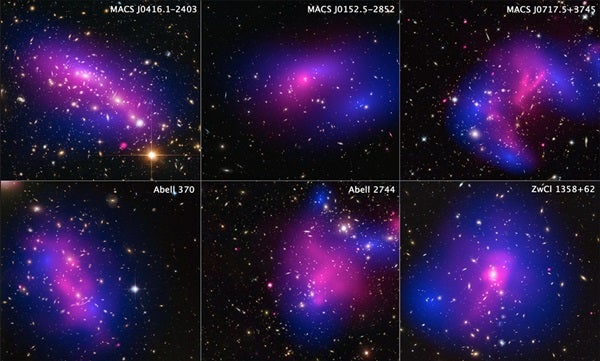Using visible-light images from Hubble, the team was able to map the post-collision distribution of stars and also of the dark matter (colored in blue), which was traced through its gravitational lensing effects on background light. Chandra was used to see the X-ray emission from impacted gas (pink).
Dark matter is a transparent form of matter that makes up most of the mass in the universe. Because dark matter does not reflect, absorb, or emit light, it can only be traced indirectly, such as by measuring how it warps space through gravitational lensing, where the light from distant sources is magnified and distorted by the gravitational effects of dark matter.
The two space observatories were used to study how dark matter in clusters of galaxies behaves when the clusters collide. Hubble was used to map the post-collision distribution of stars and dark matter, which was traced through its gravitational lensing effects on background light. Chandra was used to see the X-ray emission from the colliding gas.
“Dark matter is an enigma we have long sought to unravel,” said John Grunsfeld of NASA’s Science Mission Directorate in Washington, D.C. “With the combined capabilities of these great observatories, both in extended mission, we are ever closer to understanding this cosmic phenomenon.”
To learn more about dark matter, researchers can study it in a way similar to experiments on visible matter by watching what happens when it bumps into celestial objects. An excellent natural laboratory for this analysis can be found in collisions between galaxy clusters.
Galaxy clusters are made of three main ingredients: galaxies, clouds of gas, and dark matter. During collisions, the clouds of gas enveloping the galaxies crash into each other and slow down or stop. The galaxies are much less affected by the drag from the gas, and because of the huge gaps between the stars within them, they do not have a slowing effect on each other.
“We know how gas and galaxies react to these cosmic crashes and where they emerge from the wreckage. Comparing how dark matter behaves can help us narrow down what it actually is,” said David Harvey of the École Polytechnique Fédérale de Lausanne (EPFL) in Switzerland.
Harvey and his team used data from Hubble and Chandra to study 72 large cluster collisions. The collisions happened at different times and are seen from different angles — some from the side and others head-on.
The leading theory is that dark matter particles spread throughout the galaxy clusters do not frequently bump into each other. The reason the dark matter doesn’t slow down is because not only does it not interact with visible particles, but it also infrequently interacts with other dark matter. The team has measured this “self-interaction” and found it occurs even less frequently than previously thought.
“A previous study had seen similar behavior in the Bullet Cluster,” said team member Richard Massey of Durham University in the United Kingdom. “But it’s difficult to interpret what you’re seeing if you have just one example. Each collision takes hundreds of millions of years, so in a human lifetime we only get to see one freeze-frame from a single camera angle. Now that we have studied so many more collisions, we can start to piece together the full movie and better understand what is going on.”
By finding that dark matter interacts with itself even less than previously thought, the team has successfully narrowed down the properties of dark matter. Particle physics theorists now have a smaller set of unknowns to work with when building their models.
“It is unclear how much we expect dark matter to interact with itself because dark matter is already going against everything we know,” said Harvey. “We know from previous observations that it must interact with itself reasonably weakly, however this study has now placed it below that of two protons interacting with one another, which is one theory for dark matter.” Harvey said that the results suggest that dark matter is unlikely to be only a kind of dark proton. If dark matter scattered like protons do with one another (electrostatically), it would have been detected. “This challenges the idea that there exists ‘dark photons,’ the dark matter equivalent of photons,” he said.
Dark matter could potentially have rich and complex properties, and there are still several other types of interactions to study. These latest results rule out interactions that create a strong frictional force, causing dark matter to slow down during collisions. Other possible interactions could make dark matter particles bounce off each other like billiard balls, causing dark matter particles to be ejected from the clouds by collisions or for dark matter blobs to change shape. The team will be studying these next.
To further increase the number of collisions that can be studied, the team is also looking to study collisions involving individual galaxies, which are much more common.
“There are still several viable candidates for dark matter, so the game is not over, but we are getting nearer to an answer,” said Harvey. “These ‘astronomically large’ particle colliders are finally letting us glimpse the dark world all around us but just out of reach.”











